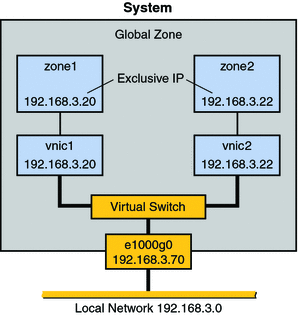Flow Control for the Virtual Network
This scenario shows how flow control is used within a virtual network, such as the basic virtual network that is introduced in Basic Virtual Network on a Single System.
Figure 10–4 Basic Virtual Network With Flow Controls

The topology is described in Basic Virtual Network on a Single System. Here a host has one network interface, e1000g0, with two VNICs, vnic1 and vnic2. zone1 is configured over vnic1, and zone2 is configured over vnic2. Resource management for the virtual network involves creating flows on a per-VNIC basis. These flows define and isolate packets with similar characteristics, such as port number or IP address of the sending host. You assign bandwidth based on the usage policy for the system.
Another very common usage for flow controls on VNIC traffic is by companies that rent out zones. You create different service level agreements for customers, and rent out zones with a guaranteed amount of bandwidth. When you create flows on a per-zone basis, you can isolate and observe each customer's traffic and monitor bandwidth usage. If your service level agreement is based strictly on usage, you can use Solaris statistics and accounting features to bill customers.
Flow controls are effective for any network that requires bandwidth management for traffic over zones. Larger organizations, such as application service providers (ASPs) or Internet service providers (ISP), can take advantage of resource control for VNICs for data centers and for multiprocessor systems. The individual zones can be rented out to customers for different levels of service. Therefore, you could rent out zone1 at the standard price and offer a standard bandwidth. Then, you could rent out zone2 at a premium price and give that customer a high level of bandwidth.
- © 2010, Oracle Corporation and/or its affiliates
